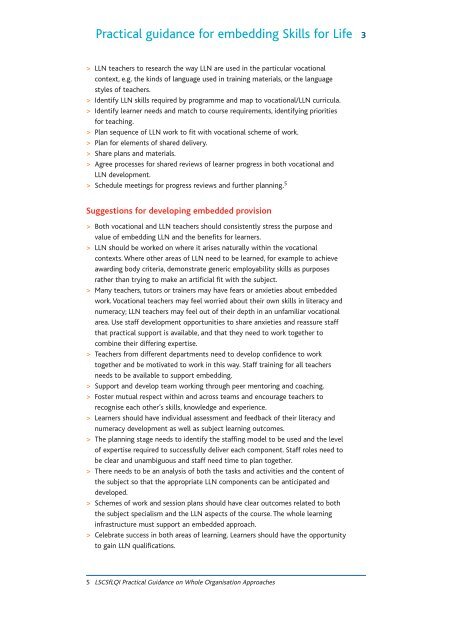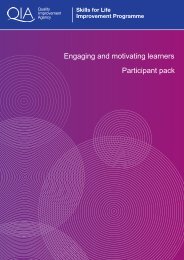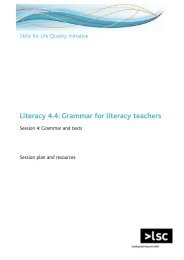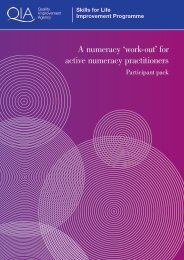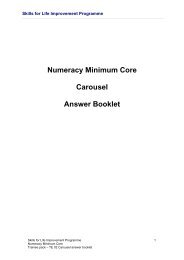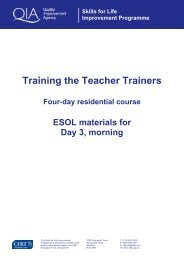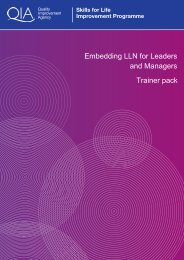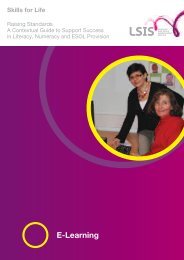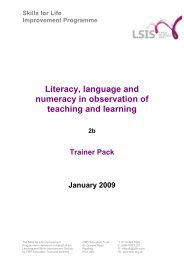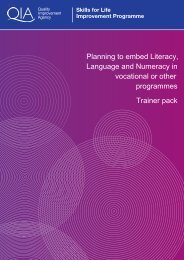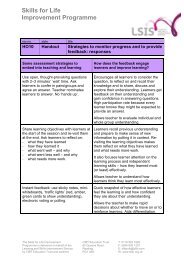Practical guidance for embedding Skills for Life - Excellence Gateway
Practical guidance for embedding Skills for Life - Excellence Gateway
Practical guidance for embedding Skills for Life - Excellence Gateway
You also want an ePaper? Increase the reach of your titles
YUMPU automatically turns print PDFs into web optimized ePapers that Google loves.
<strong>Practical</strong> <strong>guidance</strong> <strong>for</strong> <strong>embedding</strong> <strong>Skills</strong> <strong>for</strong> <strong>Life</strong> 3> LLN teachers to research the way LLN are used in the particular vocationalcontext, e.g. the kinds of language used in training materials, or the languagestyles of teachers.> Identify LLN skills required by programme and map to vocational/LLN curricula.> Identify learner needs and match to course requirements, identifying priorities<strong>for</strong> teaching.> Plan sequence of LLN work to fit with vocational scheme of work.> Plan <strong>for</strong> elements of shared delivery.> Share plans and materials.> Agree processes <strong>for</strong> shared reviews of learner progress in both vocational andLLN development.> Schedule meetings <strong>for</strong> progress reviews and further planning. 5Suggestions <strong>for</strong> developing embedded provision> Both vocational and LLN teachers should consistently stress the purpose andvalue of <strong>embedding</strong> LLN and the benefits <strong>for</strong> learners.> LLN should be worked on where it arises naturally within the vocationalcontexts. Where other areas of LLN need to be learned, <strong>for</strong> example to achieveawarding body criteria, demonstrate generic employability skills as purposesrather than trying to make an artificial fit with the subject.> Many teachers, tutors or trainers may have fears or anxieties about embeddedwork. Vocational teachers may feel worried about their own skills in literacy andnumeracy; LLN teachers may feel out of their depth in an unfamiliar vocationalarea. Use staff development opportunities to share anxieties and reassure staffthat practical support is available, and that they need to work together tocombine their differing expertise.> Teachers from different departments need to develop confidence to worktogether and be motivated to work in this way. Staff training <strong>for</strong> all teachersneeds to be available to support <strong>embedding</strong>.> Support and develop team working through peer mentoring and coaching.> Foster mutual respect within and across teams and encourage teachers torecognise each other’s skills, knowledge and experience.> Learners should have individual assessment and feedback of their literacy andnumeracy development as well as subject learning outcomes.> The planning stage needs to identify the staffing model to be used and the levelof expertise required to successfully deliver each component. Staff roles need tobe clear and unambiguous and staff need time to plan together.> There needs to be an analysis of both the tasks and activities and the content ofthe subject so that the appropriate LLN components can be anticipated anddeveloped.> Schemes of work and session plans should have clear outcomes related to boththe subject specialism and the LLN aspects of the course. The whole learninginfrastructure must support an embedded approach.> Celebrate success in both areas of learning. Learners should have the opportunityto gain LLN qualifications.5 LSCSfLQI <strong>Practical</strong> Guidance on Whole Organisation Approaches


